#cleancoding
Explore tagged Tumblr posts
Text
"The Clean Coder: A Code of Conduct for Professional Programmers" by Robert C. Martin, also known as Uncle Bob, is a seminal book that delves into the principles of professionalism in software development. It provides practical advice on how to behave, communicate, and work effectively as a software professional. Below is a user-friendly, step-by-step breakdown of the key outcomes and takeaways from the book, designed to help developers enhance their professionalism and career growth.
#TheCleanCoder#RobertCecilMartin#CleanCode#SoftwareDevelopment#ProfessionalDeveloper#CodingBestPractices#AgileDevelopment#SoftwareEngineering#TechBooks#DeveloperEthics#TechEducation#SoftwareCraftsmanship#CleanCoding#ProgrammingBooks#DeveloperMindset#BestPractices#CodingDiscipline#CodeQuality#TechLeadership#DevelopmentCulture#SoftwareDesign#TechTutorial#ProgrammingTips#DeveloperCommunity#TechBooksReview
0 notes
Video
youtube
Semantic HTML: What It Is and Why It Matters!
🚨 NEW VIDEO ALERT! 🚨
In today's video, we'll introduce an important concept in web development known as semantics. Semantic HTML helps provide proper meaning to your markup, while also making your website more accessible, improving your SEO, and keeping your code clean and organized. Enjoy! 🎉
#coding #html #semantichtml #webdevelopment #cleancode
https://youtu.be/Pf0LC6Rx9dg?si=sNtraatCLbZvzUfk
#coding#html#semantichtml#semantic html#webdevelopment#webdev#web development#cleancode#clean code#thecommoncoder#the common coder
3 notes
·
View notes
Text
#TechnicalDebt#CustomSoftware#SoftwareDevelopment#CodeQuality#Refactoring#AgileDevelopment#TechDebtManagement#SoftwareEngineering#ProjectManagement#CleanCode
0 notes
Text
What Is MVC Architecture in Full‑Stack Development?
This article explores the MVC (Model‑View‑Controller) design pattern—a foundational architecture in full‑stack web development. It breaks down MVC into three distinct components: the Model (encapsulating data and business logic), the View (handling user interface and presentation), and the Controller (managing user input and orchestrating data flow). The piece outlines how MVC improves code organization, maintainability, testability, and teamwork by enforcing a clean separation of concerns. Examples are drawn from popular web frameworks, illustrating its practical adoption in real‑world full‑stack environments.
#MVC#FullStackDevelopment#WebDevelopment#ModelViewController#SoftwareArchitecture#CodingPatterns#WebFrameworks#ScalableCode#CleanCode#FrontendBackend#TechTutorials
0 notes
Text

🚨 Day 15 of 100 Days, 100 Innovations!
🕒 Introducing: Atikin TimeBuddy – Your New Superpower for Time!
📦 Just dropped a blazing-fast, zero-dependency NPM package that will make working with dates & time in JavaScript feel like magic! 🪄
✅ 2 minutes ago? Easy. ✅ In 5 days? Just a function away. ✅ Add days, subtract hours, check weekends, calculate working days… ALL with ONE lightweight tool.
🔧 Built for developers who are done with bloated libraries like moment.js.
📌 Package Name: Atikin TimeBuddy 📦 Now on npm 🛠️ 100% pure JavaScript. No dependencies. No BS. Just power.
const { timeAgo } = require('atikin-timebuddy'); console.log(timeAgo('2025-06-14T20:00:00')); // 👉 "x hours ago"
🔗 Try it. Star it. Use it daily.
#AtikinVerse#100Days100Innovations#OpenSource#JavaScript#NPM#DeveloperTools#TimeUtils#TimeBuddy#Nodejs#Frontend#WebDev#Productivity#CleanCode
0 notes
Text
Top 10 Best Practices for Structuring React Apps for Long-Term Success
Explore the top 10 best practices for structuring React apps to build scalable, maintainable, and efficient applications that stand the test of time.
#ReactJS#ReactBestPractices#WebDevelopment#FrontendDevelopment#CleanCode#ScalableApps#JavaScript#SoftwareDevelopment#TechTips
0 notes
Text
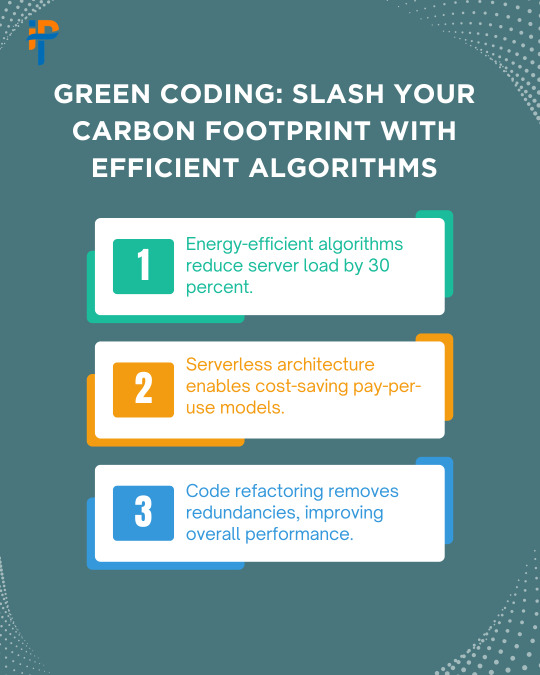
Green Coding: Reduce Emissions & Costs with Smarter Code
Optimise performance and sustainability with efficient algorithms, serverless architecture, and clean code. 💡 Case Study: One client cut AWS costs by 50% using microservices.
0 notes
Text
Building a Smarter Digital Future Through Web & Mobile Development

Today, every business, regardless of size, needs to think digital first. Whether you're offering products, services, or content, a strong online presence can determine how people perceive and interact with your brand. That’s where expert Web & Mobile Development comes into play—it’s the backbone of a successful digital strategy.
Why It Matters Now More Than Ever
Your website and mobile app aren’t just platforms—they’re tools to solve problems, engage users, and grow your brand. The best Web & Mobile Development focuses on creating smooth, responsive, and user-friendly experiences across all devices. Without it, you're missing out on visibility, engagement, and conversions.
Key Features That Define Modern Development
User-friendly navigation: A simple, clear structure ensures visitors stay longer and explore more.
Responsive layouts: From desktops to mobile phones, your design needs to adapt to every screen.
Cross-platform compatibility: Functionality must be seamless across Android, iOS, and the web.
Mobile-first mindset: Today’s development begins with optimizing for smartphones before anything else.
Clean coding practices: Well-structured code leads to fewer errors, faster load times, and easier updates.
Secure architecture: A safe user experience builds trust and protects sensitive data.
Real-time engagement tools: Features like live chat and notifications improve connection with your audience.
What Sets Great Development Apart
Effective developers combine technical skills with business insight. They align the build with your long-term digital strategy, ensuring every feature serves a real purpose. It’s not just about launching an app—it’s about building something that supports your goals.
Final Thoughts
Investing in professional Web & Mobile Development isn't a luxury—it's a necessity in the digital age. It’s how your brand meets people where they are, performs reliably, and stays ahead of the curve.
#WebDevelopment#MobileApps#DigitalStrategy#UserExperience#ResponsiveDesign#CleanCode#MobileFirst#TechInnovation
0 notes
Text

🔍 Why Choose Kanhasoft for Custom Software Development?
At Kanhasoft, we don’t just build software — we deliver tailored solutions that grow with your business. Here’s why clients trust us:
✅ Custom web & mobile software solutions ✅ Skilled in-house development team ✅ Agile process with iterative releases ✅ Clean code & rigorous testing ✅ Scalable, robust software products ✅ Focus on quality engineering & CI/CD
💡 Whether you’re a startup or an enterprise, we bring your vision to life — efficiently and effectively.
📩 Let’s build something great together. 🌐 https://kanhasoft.com/custom-software-development.html
#Kanhasoft#SoftwareDevelopment#CustomSoftware#WebDevelopment#MobileApps#AgileDevelopment#TechPartner#CICD#CleanCode
0 notes
Text
What are the Types of Inheritance in Java? Examples and Tips to Master Inheritance
In Java, inheritance is a fundamental concept of object-oriented programming that allows one class to acquire the properties and behaviors of another. This promotes code reusability and establishes a hierarchical relationship between classes Read More...

0 notes
Text
Quy Ước Đặt Tên trong Java - Hướng dẫn đầy đủ
Quy ước đặt tên trong Java là một trong những yếu tố quan trọng giúp lập trình viên viết mã nguồn dễ đọc, dễ bảo trì và chuyên nghiệp hơn. Việc tuân thủ quy ước đặt tên không chỉ cải thiện chất lượng mã mà còn giúp các thành viên trong nhóm dễ dàng hiểu và hợp tác. Trong bài viết này, chúng ta sẽ khám phá chi tiết các quy tắc đặt tên trong Java.
Tại sao Quy Ước Đặt Tên trong Java quan trọng?
Trong lập trình, đặt tên là một nghệ thuật. Một tên biến, lớp hoặc phương thức được đặt đúng cách sẽ:
Tăng tính dễ đọc: Mã nguồn dễ hiểu hơn, đặc biệt khi làm việc nhóm.
Giảm lỗi: Tên rõ ràng giúp tránh nhầm lẫn khi sử dụng biến hoặc phương thức.
Dễ bảo trì: Việc bảo trì và mở rộng mã trở nên đơn giản hơn.
Chuyên nghiệp hơn: Tuân thủ các tiêu chuẩn của Java làm tăng uy tín của lập trình viên.
Theo chuẩn Java Naming Conventions được Oracle khuyến nghị, việc đặt tên cần tuân thủ các quy tắc cụ thể để đảm bảo tính thống nhất.
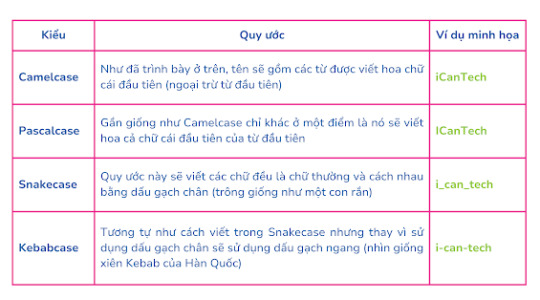
Các kiểu quy ước đặt tên
Các Quy Tắc Đặt Tên trong Java
Dưới đây là các quy tắc cụ thể cho từng loại thành phần trong Java:
1. Đặt tên lớp (Class)
Quy tắc: Tên lớp phải là danh từ, viết hoa chữ cái đầu mỗi từ (CamelCase). Ví dụ: StudentManagement, DatabaseConnection.
Ví dụ sai: studentmanagement, database_connection.
Lưu ý: Tên lớp nên rõ ràng, mô tả đúng chức năng của lớp.
2. Đặt tên phương thức (Method)
Quy tắc: Tên phương thức bắt đầu bằng chữ thường, các từ tiếp theo viết hoa chữ cái đầu (lowerCamelCase). Tên thường là động từ, mô tả hành động. Ví dụ: calculateTotalPrice(), getUserInfo().
Ví dụ sai: CalculateTotalPrice, get_user_info.
Lưu ý: Tên phương thức nên ngắn gọn, dễ hiểu.
3. Đặt tên biến (Variable)
Quy tắc: Tên biến sử dụng lowerCamelCase, ngắn gọn và mô tả rõ ý nghĩa. Ví dụ: userName, totalAmount.
Ví dụ sai: User_Name, t.
Lưu ý: Tránh sử dụng tên biến quá ngắn như a, b trừ khi trong vòng lặp ngắn.
4. Đặt tên hằng số (Constant)
Quy tắc: Tên hằng số viết hoa toàn bộ, các từ cách nhau bằng dấu gạch dưới. Ví dụ: MAX_CONNECTIONS, DEFAULT_TIMEOUT.
Ví dụ sai: maxConnections, default_timeout.
Lưu ý: Hằng số thường được khai báo với từ khóa static final.
5. Đặt tên gói (Package)
Quy tắc: Tên gói viết thường, thường sử dụng tên miền đảo ngược. Ví dụ: com.example.myapp.
Ví dụ sai: Com.Example.MyApp, myApp.
Lưu ý: Tên gói nên ngắn gọn, tránh sử dụng dấu gạch dưới.
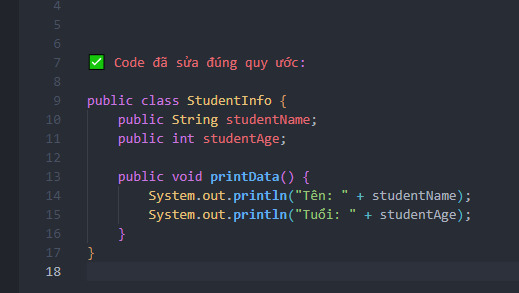
Ví dụ mã Java với Quy ước đặt tên
Một số mẹo khi áp dụng Quy Ước Đặt Tên trong Java
Sử dụng tên có ý nghĩa: Tên phải phản ánh đúng mục đích của biến, phương thức hoặc lớp. Ví dụ: thay vì data, hãy dùng userData hoặc transactionData.
Tránh viết tắt không rõ ràng: Chỉ sử dụng viết tắt khi chúng phổ biến, ví dụ: id thay vì identifier.
Giữ tên ngắn gọn nhưng đủ ý: Một cái tên dài như calculateTotalPriceOfShoppingCart có thể được rút gọn thành calculateCartTotal.
Kiểm tra tính nhất quán: Đảm bảo tất cả các thành viên trong nhóm tuân thủ cùng một quy ước đặt tên.
Sử dụng công cụ hỗ trợ: Các IDE như IntelliJ IDEA hoặc Eclipse có thể cảnh báo nếu bạn vi phạm quy ước đặt tên.
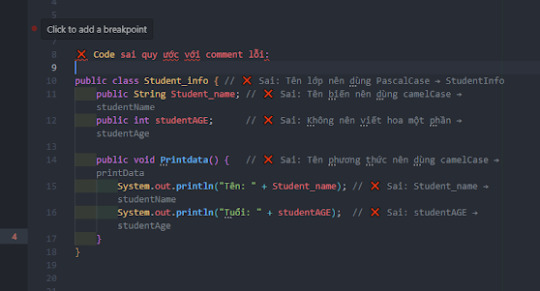
Biến và phương thức không tuân thủ quy ước đặt tên
Lợi ích của việc tuân thủ Quy Ước Đặt Tên trong Java
Việc áp dụng đúng quy ước đặt tên mang lại nhiều lợi ích lâu dài:
Cải thiện hiệu suất làm việc nhóm: Mọi người dễ dàng hiểu mã của nhau.
Tăng khả năng tái sử dụng mã: Mã dễ đọc thường được tái sử dụng nhiều hơn.
Giảm thời gian gỡ lỗi: Tên rõ ràng giúp nhanh chóng xác định lỗi.
Tạo ấn tượng chuyên nghiệp: Nhà tuyển dụng hoặc khách hàng sẽ đánh giá cao mã nguồn được viết chuẩn.
Các lỗi phổ biến khi Đặt Tên trong Java
Sử dụng tên không rõ ràng: Ví dụ: temp, x thay vì temporaryResult, index.
Phá vỡ quy tắc CamelCase: Ví dụ: get_userInfo thay vì getUserInfo.
Sử dụng ký tự đặc biệt: Tránh các ký tự như @, # trong tên.
Tên quá dài hoặc quá ngắn: Tên quá dài gây khó đọc, quá ngắn không đủ ý nghĩa.
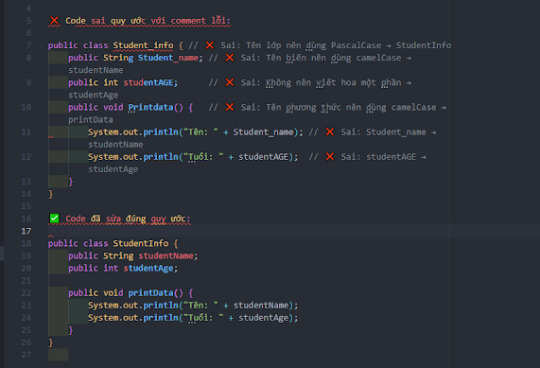
So sánh mã nguồn đúng và sai
Kết luận
Quy ước đặt tên trong Java không chỉ là một tập hợp các quy tắc khô khan mà còn là công cụ giúp lập trình viên tạo ra mã nguồn chất lượng cao. Bằng cách tuân thủ các quy tắc về đặt tên lớp, phương thức, biến, và hằng số, bạn sẽ cải thiện đáng kể khả năng đọc, bảo trì và mở rộng mã. Hãy áp dụng các mẹo được chia sẻ trong bài viết này và sử dụng các công cụ hỗ trợ để đảm bảo mã của bạn luôn chuyên nghiệp.
Quy Ước Đặt Tên trong Java – Hướng Dẫn Đầy Đủ & Chuẩn Nhất Hiểu rõ cách đặt tên biến, class, method... theo chuẩn Java giúp code rõ ràng, dễ đọc và chuyên nghiệp hơn. 🌍 Website: Java Highlight #JavaHighlight #Java #JavaNamingConventions #LapTrinhJava #JavaTips #JavaStyleGuide #JavaBestPractices #JDKlagi #JRElagi #JVMLagi #CleanCode #JavaCodingStyle
#java highlight#JavaHighlight#Java#JavaNamingConventions#LapTrinhJava#JavaTips#JavaStyleGuide#JavaBestPractices#JDKlagi#JRElagi#JVMLagi#CleanCode#JavaCodingStyle
0 notes
Text
Built to Perform Backend Solutions With Node.js

Need a solid backend that just works? ⚙️💻 At Shine Infosoft, we use Node.js to build fast, reliable apps and APIs—nothing flashy, just clean code that keeps your project running smoothly. If you’re into smart builds without the noise, let’s connect. 🛠️✨
#ShineInfosoft#NodeJSDevelopment#BackendMadeSimple#WebDevelopment#NodeJSExperts#CleanCode#ScalableApps#TechWithoutTheFluff#AppDevelopment#ModernTech#WebDevCommunity#CodeThatWorks#ServerSideDevelopment#TechPartner
0 notes
Text
wraptmdb: Un wrapper asincrono per TMDb fatto per sviluppatori... e per chi ama il cinema
Nel vasto panorama delle API disponibili online, The Movie Database (TMDb) rappresenta una vera e propria miniera d’oro per gli appassionati di cinema e serie TV. Questa risorsa gratuita e costantemente aggiornata offre dati dettagliati su film, serie, attori e molto altro. Ma come sfruttare al meglio questo potenziale, soprattutto se si è sviluppatori Python? La risposta è wraptmdb, un progetto…
#AsyncPython#CinemaData#CleanCode#coding#DevLife#DevShowcase#FilmTech#IndieDev#MadeWithPython#MovieLovers#OpenSource#PyPI#Python#SoftwareDevelopment#TMDb
0 notes
Text

A stunning website is pointless if it doesn’t perform. Let us code your brand into success.
#WebDevelopment#WebDev#WebsiteDesign#CodeLife#FrontEndDevelopment#BackEndDevelopment#FullStackDeveloper#WebDesigner#UXUIDesign#WebDesignTrends#SEOOptimized#ResponsiveDesign#SpeedMatters#MobileFirstDesign#FastLoading#WebsitePerformance#HTML5#CSS3#JavaScript#ReactJS#NodeJS#WordPressDevelopment#Bootstrap#BuiltToConvert#PixelPerfect#CleanCode#DevModeOn#DesignToDeploy#CodeAndCreate#WebDevVibes
0 notes
Text
"Working Effectively with Legacy Code" by Michael C. Feathers is a must-read for developers and software engineers who deal with legacy systems. Legacy code, often characterized by its complexity, lack of documentation, and resistance to change, can be daunting to work with. This book provides practical strategies and techniques to understand, refactor, and improve legacy codebases. Below is a user-friendly, step-by-step breakdown of the key outcomes and takeaways from the book.
#LegacyCode#Refactoring#SoftwareDevelopment#CleanCode#CodeRefactoring#TechBooks#SoftwareEngineering#WorkingWithLegacyCode#MichaelFeathers#LegacySystems#CodeQuality#TechTutorial#SoftwareMaintenance#DevelopmentBestPractices#TechEducation#SoftwareCraftsmanship#LegacyCodeTips#RefactorLegacyCode#ProgrammingBooks#TestDrivenDevelopment#AgileDevelopment#SoftwareDesign#TechLeadership#ProgrammingBestPractices#DeveloperTools#TechCommunity
0 notes
Text
React App Best Practices for Long-Term Success
Master key React app best practices to build scalable, high-performance projects that are easy to maintain and grow over the long term.
#ReactJS#ReactBestPractices#WebDev#FrontendDevelopment#ScalableApps#CleanCode#PerformanceOptimization#ReactTips#MaintainableCode#DevCommunity
0 notes